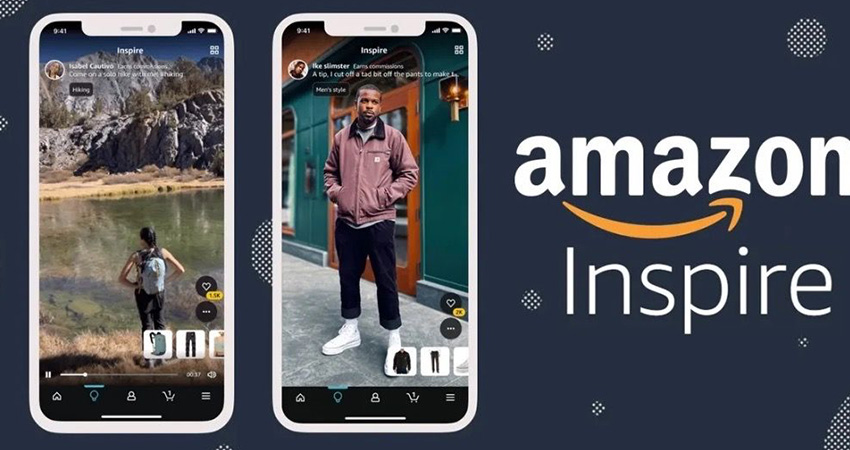Amazon plans to pay influencers $25 a video for content posted to its TikTok-like Inspire site (credit: SocialBook)
Amazon will start charging a 2% per-item fee to merchants using Seller Fulfilled Prime (SFP) starting in October, Bloomberg reports, while the company is offering influencers the equivalent of $25 a video to populate content promoting its listings as it seeks a bulwark against Chinese social giant TikTok.
The fee will not be imposed on the sale of items that are not listed in Prime, with its faster delivery promise.
Some observers say imposition of the new SFP fee is a clear indication that Amazon doesn’t fear an impending antitrust lawsuit widely expected from Federal Trade Commission chair Lina Khan. Last week the company met individually with FTC members in advance of the filing, according to various reports.
“It suggests Amazon may not think a hypothetical FTC case against them has teeth,” said Colin Sebastian, a managing director and senior analyst at Baird.
According to the Seattle Times, Amazon asked a select group of influencers to submit videos featuring products, to be used on Inspire. The video and photo feed was launched last year in reaction to TikTok’s massive success. Amazon will reportedly pay a max of $12,500 to each creator for 500 approved videos, or the equivalent of $25 each. The publication said creators charge platforms between $200 and $300 to produce a video.
Jason Boyce, a former Amazon power seller who is founder and CEO of digital agency Avenue7Media, said imposing a fee on merchants who are not using Fulfillment By Amazon (FBA) is tough for sellers to swallow. He said he was in SFP as co-founder and CEO of Dazadi.com
“I’m still trying to understand why Amazon thinks this is ok,” Boyce said. “The bar to execute SFP is very high. It’s relentlessly difficult to meet the standard and keep it going. So, I think it’s a slap in the face to sellers who are breaking their butts to execute the Prime Delivery Promise for shoppers, charging a 2% fee in order to reduce Amazon’s pick, pack and ship burden.”
Sebastian said that in his view, the new charge is like a usage fee for merchants to make Prime happen.
“It’s very expensive for Amazon to operate Prime,” Sebastian said. “If merchants want their products included in this program, they either need to use FBA as a way of paying their share, or now as an alternative, pay Amazon a separate access fee to help offset those costs.”
Amazon has been striving to cut down on its massive logistics costs, including creation of a new regional distribution and fulfillment model and offloading overbuilt network assets. Now the company plans to restart Amazon Shipping, the Wall Street Journal reports, which is bound to be an expensive endeavor. The competing service to UPS and FedEx was paused during the pandemic because massive internal volumes made it unworkable.
On the influencer/creator fee structure, Boyce said those with large enough followings can still make out through Amazon’s generous affiliate program. The upside there, he reasoned, would far outweigh the small per-video payments in relation to TikTok, and the production costs.
“They will have to increase this fee to creators if they don’t get enough influencer engagement,” he said. “Typically, Amazon makes a great initial offer only to cut it later. But starting low and raising it, if necessary, makes for a better story.”
Social, like grocery, is not easy for Amazon and not in its DNA, Boyce said, but that won’t stifle the company’s determination to dominate wherever it hangs its hat. “They are relentless and won’t stop until they figure it out, no matter how long it takes,” he said.
Amazon’s offer seems designed to cater primarily to influencers who have already built their success on commission-based earnings tied to sales. By introducing an additional $25 per video payment, the initiative serves as an added incentive for these influencers to continually churn out fresh and engaging content over an extended period.
Yoni Mazor, co-founder and chief growth officer of Getida, whose software audits Amazon sellers for reimbursement, said content creators who rely solely on video income vs. driving conversions will see the $25 fee as less alluring, unless they have “a streamlined and efficient video production process at scale.”
“It remains clear that Amazon’s latest initiative is poised more towards reshaping the landscape for influencers, providing an enticing layer for those who have mastered the art of marrying content creation with sales-driven results,” Mazor said.

